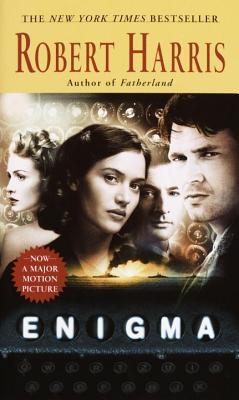
Enigma
Book Description
A world on the brink of chaos, where every secret can alter the course of history. In a British codebreaking center during World War II, tensions rise as cryptographers race against time to decode the enemy's most elusive messages. A brilliant but troubled young mathematician discovers a chilling conspiracy that could thwart their efforts and endanger countless lives. Loyalty fractures, and trust hangs by a thread as the battle of wits intensifies. In a game where every decision counts and betrayal lurks around every corner, who can be trusted when the stakes are life and death? What happens when the truth becomes the ultimate weapon?
Quick Book Summary
"Enigma" by Robert Harris is a gripping historical thriller set at Bletchley Park, the heart of Britain's codebreaking efforts during World War II. The story follows Tom Jericho, a young and gifted mathematician returning to duty after a nervous breakdown. When a new, impenetrable German naval cipher—the Shark Enigma—threatens to turn the tide of the war, Jericho and his team race against time to crack it. As they dig deeper, Jericho becomes enmeshed in a web of intrigue when his former lover, Claire, vanishes under suspicious circumstances. Amid suspicion, betrayal, and mounting danger, he uncovers secrets not just about enemy codes but about those closest to him. The suspenseful narrative reveals the pressure, paranoia, and moral ambiguity inherent in wartime espionage.
Summary of Key Ideas
Table of Contents
The Psychological Toll of Espionage
At the core of "Enigma" is Bletchley Park, the secret facility where British cryptographers are racing to break the German Enigma code, which determines the movement of enemy U-boats in the Atlantic. Tom Jericho, a brilliant but emotionally volatile mathematician, is called back to Bletchley after a breakdown, driven by his obsession with both the code and his missing lover, Claire Romilly. As tensions mount, the codebreakers discover the Germans have altered their cipher system, putting allied convoys at deadly risk. Jericho’s own mental fragility underscores the immense psychological strain faced by those engaged in relentless intellectual warfare.
The Complexity of Loyalty and Trust
Loyalty and suspicion interweave among the staff, complicated further by personal relationships and the absence of Claire, who may have ties to espionage herself. As Jericho investigates her disappearance, aided by Claire’s best friend Hester Wallace, trust becomes a central concern, not just in personal matters but in matters of national security. Every interaction is pregnant with the possibility of betrayal, and paranoia begins to gnaw at the team. The pressure to succeed is high, driven by the knowledge that decoded messages could save thousands of lives—or doom them if mishandled.
Codebreaking as a Battleground
The process of codebreaking itself is depicted as a battlefront, where mathematicians and linguists fight an intellectual war against an unyielding adversary. Harris delves into the methods, tools, and obsessive detail required to break the Enigma machine, bringing to life the monotony, setbacks, and rare breakthroughs that defined the work. Success depends not just on intellect but on intuition, luck, and the ability to see connections others cannot. The novel highlights how technological warfare made as significant an impact on WWII as physical battle.
The Impact of Betrayal and Deception
Deception and betrayal form a persistent undercurrent in the story. Multiple characters harbor secrets, and the paranoia about enemy infiltration is justified when it becomes clear there is a traitor among the codebreakers. Jericho’s pursuit merges his personal and professional crises as he untangles a conspiracy involving espionage, sabotage, and buried motivations that cut to the heart of the war effort. These revelations test friendships and loyalties to the breaking point, as trust is shattered and lives endangered.
The Human Cost of War
Ultimately, Harris dramatizes the cost of war not only in casualties and ruined lives but in the psychological toll taken on those compelled to keep secrets and make impossible choices. The complexity of wartime loyalty, the sacrifice of personal happiness for national duty, and the enduring moral ambiguities faced by the codebreakers linger beyond the novel’s resolution, reminding readers of the very human dimensions behind history’s greatest conflicts.
Download This Summary
Get a free PDF of this summary instantly — no email required.





